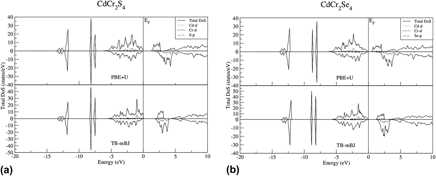Article contents
Role of Cr-d states in the electronic and optical properties of the CdCr2X4 (X = S, Se) normal ferromagnetic spinels using PBE+U and TB-mBJ potentials
Published online by Cambridge University Press: 08 May 2017
Abstract

We have investigated theoretically the role of Cr-d states in the electronic and optical properties of the CdCr2X4 (X = S, Se) normal ferromagnetic spinels using the framework of an all-electron full-potential linearized augmented plane wave method. The calculations are performed using Coulomb corrected Perdew–Burke–Ernzerhof (PBE+U) and Tran–Blaha modified-Becke–Johnson (TB-mBJ) approximations with the adding of spin–orbit coupling in both schemes. The lattice parameters have been optimized and are in agreement with the existing experimental values. We found band gap values 1.606 eV and 0.972 eV of CdCr2X4 (X = S, Se), respectively, using the TB-mBJ scheme. Analysis of the site and momentum projected densities shows that the larger splitting of Cr-d states is responsible for the larger band gap by the use of the TB-mBJ scheme. Optical properties along the directions of lattice constants are studied on the basis of band to band transitions. We found the isotropic nature of the optical properties. Reflectivity stays low up to 1.6 eV, consistent with the energy gaps obtained using the TB-mBJ scheme in both the compounds. The refractive index, n(ω), and the extinction coefficient, k(ω), are also studied by the PBE and the TB-mBJ schemes.
- Type
- Articles
- Information
- Copyright
- Copyright © Materials Research Society 2017
Footnotes
Contributing Editor: Amit Goyal
References
REFERENCES
- 2
- Cited by





